|
This past week changed the views of many regarding the strength of the economy, the difficulty in addressing liquidity problems in the financial markets, the problem of re-emerging inflation, and the creativity of the Fed. Despite subprime and liquidity issues in the financial markets, last week’s economic releases called off the recession. The initial focus of the week was the believed-by-many timidity of the Fed to aggressively cut interest rates with the fed funds target rate being cut by a mere 25 basis points instead of a hoped for 50 basis points. But the week got more interesting as the Fed announced a series of special auctions to inject liquidity into the economy. Then it got even more interesting as inflation spiked for import, producer, and consumer prices. And it turned out that the consumer is doing just fine as retail sales jumped in November even after discounting the gasoline price effects. And almost incidentally, U.S. exports hit a record high and industrial production turns out to not be in recession. So now, the Fed is trying to “manage” (if that is possible) a liquidity crunch in parts of the financial sector, a housing recession, moderate growth in most of the economy, and inflation that is heating up – not to mention skittish traders and investors who cannot decide if the economy is in recession or not. And along the way, equities dropped, interest rates rose instead of declining, and the dollar actually strengthened.
Equities ended the week down sharply. It was all about the Fed and how stronger economic data and worsening inflation are limiting future rate cuts by the central bank. The week started on an optimistic note with gains on Monday as investors fully expected the Fed to either cut rates by 50 basis points or cut by 25 basis points and put wording in the FOMC statement to indicate more cuts were coming. But on Tuesday afternoon, the Fed cut by a disappointing 25 basis points and gave no indication of further rate cuts to come. Stocks bounced back on Wednesday with the Fed’s announcement of a special series of credit auctions to more directly inject liquidity into needed areas of the financial sector. But after two earlier rounds of abysmal inflation reports on import prices on Wednesday and producer prices on Thursday, the surge in consumer prices on Friday was the final straw for the markets which pulled back expectations for interest rate cuts. Equities fell sharply at week end as a result. Small caps, being more interest-rate sensitive, fell the most for the week.
In corporate news for the week, key items included UBS warning on profits and stating it would write down $10 billion related to subprime problems. General Electric warned on 2008 earnings. H&R Block warned on quarterly losses related to its mortgage division. Other warnings related to mortgage losses included Wachovia, Bank of America, and Citigroup.

Last week, most major indexes were down: the Dow, down 2.1 percent; the S&P 500, down 2.4 percent; the Nasdaq, down 2.6 percent; and the Russell 2000, down 4.0 percent.
Year-to-date, the Dow is up 7.0 percent; the S&P 500, up 3.5 percent; and the Nasdaq, up 9.1 percent. The Russell 2000 is down 4.3 percent since year end.
Despite the Fed’s 25 basis point cut in the fed funds target rate this past Tuesday, bonds yields rose in the week. Except for Tuesday, bond rates rose throughout the week. Inflation jitters started slowly on Monday, nudging up rates. But on Tuesday, disappointment in equity markets over the Fed’s lack of aggressive rate cutting led to massive flight to quality as equities dropped sharply on the day. Some of that flight to quality unwound on Wednesday but the big issue was the jump in import prices which further weighed on bond prices. During the rest of the week, strong numbers for retail sales, producer prices, and finally a sharp jump on Friday in consumer prices led to significant gains in yields over inflation concerns and that the Fed does not have much if any room to ease further.
Treasury yields were up last week except for the near end as follows: the 2-year note; up 20 basis points; the 5-year note, up 12 basis points; the 10-year bond, up 12 basis points; and the 30-year bond, up 9 basis points. The 3-month T-bill dropped 21 basis points over the week.

Rates were up last week and this time the emphasis was on stronger economic data and fears of higher inflation.
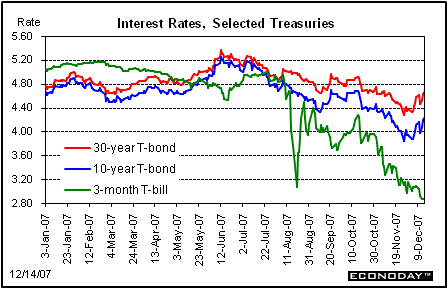
Oil prices ended up over the past week but remained moderately below the record high. Key factors behind the increase were winter storms in the Midwest and Northeast as well as an unexpected drop in inventories of crude and heating oil. Also, on Wednesday the Energy Information Administration released its 2008 outlook and raised its projections for oil prices significantly. Finally, robust retail sales numbers for November and healthy industrial production numbers for the same month indicated that the U.S. economy was growing more than expected.
The spot price for West Texas Intermediate rose $2.99 per barrel for the week to close at $91.27 per barrel, $7.61 below the record high of $98.88 set November 20th.


Weekly percent change column reflects percent changes for all components except interest rates. Interest rate changes are reflected in simple differences.
Views on the economy changed quite a bit last week as the economy turned out to be relatively strong and inflation jumped. The lead story, however, was the Fed’s caution in not cutting interest rates too much – which now appears to be correct based on resurging inflation.
At its December 11 FOMC meeting, the Fed disappointed markets by cutting the fed funds target and the discount rate by only 25 basis points each. Many had expected either a 50 basis point cut in both or at least an additional 25 basis point cut in the discount rate if the Fed only lowered fed funds by 25 basis points. Due to concern over continuing strains within the financial markets, the Federal Open Market Committee cut the fed funds target rate by 25 basis points as expected by the markets. The Fed also cut its discount rate by 25 basis points. The fed funds target rate is now 4-1/4 percent and the discount rate is now 4-3/4 percent. But what really disappointed the markets was that the Fed gave no indication that further interest rate cuts are likely. The statement did not rule them out either and the Fed appears to be taking a wait and see approach for the next move. Equities dropped sharply on the news of the Fed’s cautious stance.

The difficulty the Fed is facing is that portions of the economy indeed are weak but also that inflation is picking up. While markets have worried about economic growth being too weak, markets have forgotten that the Fed is charged with the responsibility of worrying about both economic growth (specifically as impacting employment) and inflation. Within the FOMC statement, the Fed notes that the risks have risen both for economic growth that is too weak and for inflation that is too high.
“Recent developments, including the deterioration in financial market conditions, have increased the uncertainty surrounding the outlook for economic growth and inflation. The Committee will continue to assess the effects of financial and other developments on economic prospects and will act as needed to foster price stability and sustainable economic growth.”
The Fed appears to believe that for now it has taken a balanced position with current interest rates. But it turns out that on the day after the meeting that the Fed had additional plans for addressing credit issues.
The Fed has decided that liquidity problems in the financial markets and managing the balance between inflation and economic growth are significantly separate issues – at least in part. Rather than just using changes in overall interest rates to attempt to solve subprime related liquidity problems, the Fed has clearly taken a broader approach which expanded even more this past week. First, the Fed in mid-August lowered the discount rate relative to fed funds in order to encourage financial institutions to borrow from the Fed if they have liquidity problems. But this past week, the Fed adopted a strategy already used by European central banks – creating special auctions of credit to inject more liquidity into the financial system.
The Fed has created a temporary Term Auction Facility (TAF) to conduct four scheduled auctions of credit of $20 billion each. The auction is available to “all depository institutions that are judged to be in generally sound financial condition by their local Reserve Bank and that are eligible to borrow under the primary credit discount window program.” Participating in this auction will not have the stigma of going to the discount window as seen by some. Also, a broader range of collateral will be accepted by the Fed than at the discount window. This opens up the auction to some who would not qualify for going to the discount window with certain collateral. The minimum bid for the first auction on Monday, December 17 is 4.17 percent which is well below the fed funds target rate of 4.25 percent and is another reason many may participate. The results of the first auction will be announced Wednesday, December 19 at 10:00 a.m. This announcement could actually be a market mover depending on how markets perceive the Fed’s TAF plan to be helping liquidity problems or not. Stay tuned.
Headline CPI inflation touched on highs in November and corroborates the Fed’s concerns that inflation is potentially rebounding. Core inflation also firmed. Consumer prices spiked in November, up 0.8 percent overall with the core breaking a long streak of moderate 0.2 percent gains with a 0.3 percent rise. Year-on-year prices jumped, especially the overall rate of 4.3 percent which was the highest since 4.4 percent seen in October 2005. The core rate is at 2.3 percent, above the 2.0 percent Federal Reserve comfort limit.

Headline inflation was led by energy components with gasoline surging a monthly 9.3 percent in November to hit a 37.1 percent year-on-year rate. Fuel oil jumped 14.2 percent in the month. But higher oil prices are sloshing into core components as airfares jumped 2.6 percent for the month.
Upward price pressures are widespread, including apparel spiking 0.8 percent, education up 0.6 percent, medical up 0.4 percent, and even shelter firming to 0.3 percent. However, the apparel price hike is a little suspicious and could simply reflect cold weather boosting winter apparel more than usual and reducing the need for discounts.
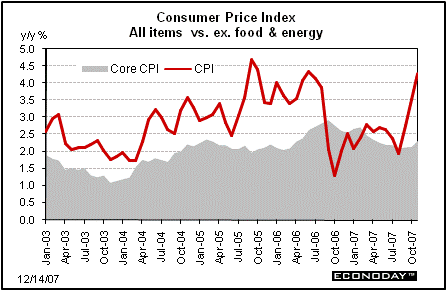
The energy induced jump in headline inflation to 4.3 percent on a year-on-year basis certainly explains why recent Fedspeak indicated a shift in focus in inflation “targets” from core measures to headline readings. The latest Fed forecast calls for long-term headline and core inflation to be in the 1-1/2 to 2 percent range for the PCE price index. The CPI tends to run about 0.2 to 0.3 annual percentage points more than the PCE price index.
Inflation is picking up at just about every stage – not just the consumer level. Overall producer prices in November surged while the core rate also heated up sharply. The overall PPI spiked 3.2 percent in November, following a 0.1 percent uptick in October. The November increase was the largest since the 3.5 percent boost seen for August 1973. In the latest month, the core rate jumped to a 0.4 percent increase, following no change in October. For the overall PPI, the November surge was led by a 14.1 percent jump in energy costs, following a 0.8 percent dip the month before. Gasoline jumped 34.8 percent after declining 3.1 percent in October. Heating oil and diesel fuel also posted strong gains. Prices for light motor trucks rebounded 2.3 percent in November after decreasing 2.7 percent the prior month.

The year-on-year rate for the overall PPI jumped to up 7.7 percent in November from up 6.0 percent in October. The year-on-year core rate, however, declined to up 1.9 percent in November, compared to up 2.5 percent in October.
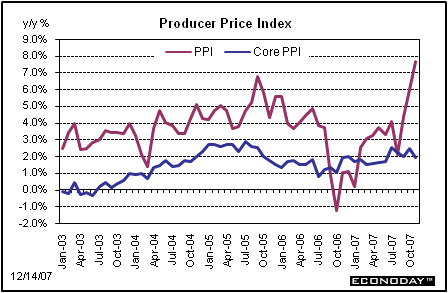
The surge in producer prices was pervasive at all stages of production. Overall prices at the crude level jumped 8.7 percent in November, following a 2.4 percent jump in October. At the intermediate level, prices increased 3.7 percent, following a 0.1 advance in October.
The low dollar, strong economies overseas, and high oil prices are fueling a strengthening in import prices. Indeed, price inflation is picking up in most facets of the economy – including from import prices. Import prices surged 2.7 percent in November, following a 1.4 percent gain the prior month. The latest monthly increase is the largest in 17 years. Import prices excluding petroleum are also showing pressure, up 0.7 percent in the month after a 0.5 percent advance in October.

Year-on-year, overall import prices in November were up 3.4 percent, the strongest pace since the 3.8 percent in October of 2005. Petroleum import prices were up 53.0 percent while nonpetroleum import prices were up 3.0 percent year-on-year.
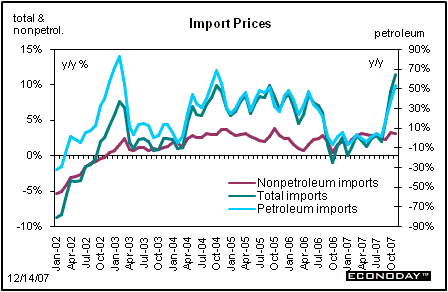
Retail sales got a big boost in November from surging gasoline prices but still were surprisingly strong in other components. Overall retail sales jumped 1.2 percent in November after a 0.2 percent rise the month before. Excluding motor vehicles, the increase was a robust 1.8 percent, after a 0.4 percent boost in October. But gasoline was the key factor in the gain as gasoline sales spiked 6.8 percent after a 3.1 percent rise in October. Nonetheless, sales excluding gasoline rose 0.6 percent in November, compared to a 0.1 percent decline in October. Excluding both motor vehicles and gasoline, retail sales increased a robust 1.1 percent in November, but showing improvement over the modest 0.1 percent uptick in October. For the latest month, strength was widespread but led by gasoline, clothing, and electronics. Weakness was led by motor vehicles. Overall, the November retail sales report completely rewrites views on the strength of the consumer sector. Certainly the sharp increase in consumer prices for the month will deflate the large numbers for November but nonetheless, consumer spending was healthy and should lead to upward revisions for fourth quarter GDP. The latest shopping spree by U.S. consumers will mean that the Fed may not be getting as much of the needed slowing in growth as it had forecast. But the good news is that the recession seems to have been called off.

Despite some recently sluggish manufacturing surveys (other than the Empire State survey), industrial production and especially the manufacturing component came in healthy for the month of November. Industrial production bounced back, rebounding 0.3 percent from a 0.7 percent drop in October. The gain was centered in the important manufacturing component which rose 0.5 percent to almost reverse October's 0.6 percent drop. Manufacturing strength was once again centered in business equipment which jumped 0.9 percent though the year-on-year rate is a bit mild at 4.0 percent. U.S. manufacturing clearly is benefitting from a weak dollar and growth overseas. Consumer goods are another story, extending a long run of monthly declines with a 0.2 percent dip in November. However, looking forward, the latest boost in consumer spending could help firm up the manufacturing sector.
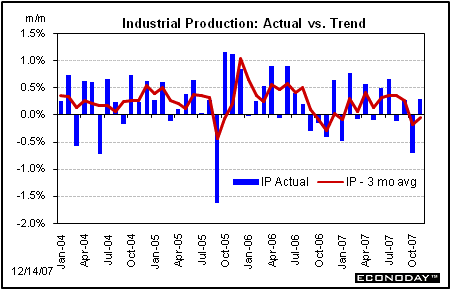
Exports are indeed fueling manufacturing in the U.S., according to the October trade report even as higher oil prices are causing the trade gap to grow. The U.S. trade gap widened in October to $57.8 billion from $57.1 billion in September. Overall exports rose 0.9 percent in October to a record high $141.7 billion. The gain was led by a rebound in capital goods exports. Meanwhile overall imports increased 1.0 percent for the month, a jump in oil imports being the primary reason. Much of the increase in oil imports was price related. Crude oil prices in October rose sharply, jumping to $72.49 per barrel from $68.51 per barrel in September.

But it is notable that the non-oil trade gap actually narrowed a little. If oil prices stabilize or even decline, the trade gap should show significant improvement in the months ahead, reflecting the health of export demand.
Inflation is rearing back up and, outside of housing, signs of recession have disappeared. The Fed appears to be intent on cautious use of interest rates in addressing current liquidity problems. Even though the Fed indicated in its latest FOMC statement that the risks between low growth and high inflation are balanced, this past week’s data likely tipped the balance away from recession toward worrying about inflation. And, in turn, odds of further easing by the Fed have been slipping.
This coming week we get only a few market moving indicators but two are key right now: housing starts on Tuesday and personal income on Friday which includes the PCE price indexes. We also get GDP on Thursday but with GDP down to its final revision, it likely will not get much attention. Other data are released on the manufacturing and consumer sectors. But investors may see some wild rides in the financial markets as this coming week is the last full week of trading for the year and many market participants will be setting their year-end positions before heading off for the holidays.
The Empire State manufacturing index in November dipped only fractionally to 27.4, reflecting a steady and healthy rate of new orders and shipments that are near the headline level. The New York Fed’s manufacturing index has been the outlier, being notably stronger than most of the recent indicators for manufacturing which have ranged from slightly negative to marginally positive.
Empire State Manufacturing Survey Consensus Forecast for December 07: 21.5
Range: 19.0 to 27.0
Housing starts in October made a partial rebound but permits continued to spiral downward. Housing starts in October rose 3.0 percent, following a revised 11.4 percent drop in September. October’s 1.229 million unit annual rate was down 16.4 percent on a year-on-year basis. However, overall permits fell 6.6 percent, following a 4.6 percent decline the month before. The decline in permits more likely represents the true status of housing in October. With continued high supply of unsold new and existing homes and with continued weakness in prices, there is little reason for builders to boost starts.
Housing starts Consensus Forecast for November 07: 1.180 million-unit rate
Range: 1.130 million to 1.210 million-unit rate
GDP for the third quarter for the second estimate for the period was revised upward sharply to an annualized 4.9 percent from the initial estimate of 3.9 percent. The upward revision was primarily due to a higher estimate for inventory investment and for stronger net exports. On the inflation front, the GDP price index was revised upward slightly to an annualized 0.9 percent from the initial estimate of 0.8 percent as energy was actually a positive (tugging downward) that period. The core PCE price index was unrevised at an annualized 1.8 percent. Any notable revisions are likely to be in the inventory or next exports components. Markets will be more focused on Friday’s more current data for personal income, consumption, and PCE price indexes for November, which will give us a good look at trends within the fourth quarter.
Real GDP Consensus Forecast for final Q3 07: 4.9 percent annual rate
Range: +4.9 to +5.1 percent annual rate
GDP price index Consensus Forecast for final Q3 07: +0.9 percent annual rate
Range: +0.8 to +0.9 percent annual rate
Initial jobless claims fell 7,000 in the week ending December 8 to 333,000, pushing down the 4-week average to 338,750. There were no special factors in the week. The numbers continue to portray a moderately tight labor sector.
Jobless Claims Consensus Forecast for 12/15/07: 335,000
Range: 320,000 to 343,000
The Conference Board's index of leading indicators fell 0.5 percent in October, following a rise of 0.1 percent in September. The largest negatives in October were building permits, jobless claims, and consumer expectations, offset in part by gains in the stock market, rising money supply, and new orders for manufacturers. Thus far, the index of leading indicators is pointing to only slow growth rather than an outright recession. The index of leading indicators usually does not get much market attention but interest does pick up during periods seen as potential turning points in the economy.
Leading indicators Consensus Forecast for November 07: -0.3 percent
Range: -0.5 to +0.1 percent
The general business conditions component of the Philadelphia Fed's business outlook survey index inched 1.4 points higher in November to 8.2, remaining in a modestly positive range. New orders and shipments also were barely in positive territory, indicating a very sluggish manufacturing sector in the mid-Atlantic. Price readings were mixed with prices paid relatively steady and coming in at 37.7 while prices received showed increasing pressure, rising about 6 points to 18.6.
Philadelphia Fed survey Consensus Forecast for December 07: 6.2
Range: 0.5 to 8.0
Personal income in October softened while core inflation remained a little on the high side. Personal income slowed to a 0.2 percent rise in October, following a 0.3 percent increase the prior month. Within personal income, the wages and salaries component weakened sharply to a 0.1 percent advance, following a 0.6 percent increase in September. On the spending side, the consumer is increasingly cautious. Personal consumption in October rose a modest 0.2, following a 0.3 percent increase in September. On the inflation front, the core PCE price index rose 0.2 percent in October, matching the increase in the prior month. The overall PCE price index increased 0.3 percent, the same as in September.
More recently, moderate employment gains in November and a 0.5 percent spike in average hourly earnings point toward a healthy gain in personal income or at least the wages & salaries component. Retail sales in November surged 1.2 percent and provide strong support for the durables and nondurables portions of personal consumption. The core consumer price index accelerated from 0.2 percent in October to a 0.3 percent increase in November, suggesting that the core PCE price index also likely will firm above a recent string of 0.2 percent increases.
Personal income Consensus Forecast for November 07: +0.5 percent
Range: +0.4 to +0.5 percent
Personal consumption expenditures Consensus Forecast for November 07: +0.8 percent
Range: +0.5 to +1.0 percent
Core PCE price index Consensus Forecast for November 07: +0.2 percent
Range: +0.1 to +0.3 percent
The Reuter’s/University of Michigan’s Consumer sentiment index dipped back more than 1-1/2 points to 74.5 for the preliminary December reading. The expectations component is the most closely watched category and it posted a nearly 3 point dip to 63.2 for its lowest reading since the invasion of Iraq. Confidence in the present situation edged higher to 92.1, but remained near a 3-1/2 year low. Inflation expectations are more trouble, up one tenth for the 1-year outlook to 3.5 percent and up 2 tenths for the 5-year outlook to 3.1 percent. The Fed will certainly be watching to see if inflation expectations are becoming unanchored.
Consumer sentiment Consensus Forecast for final December 07: 74.5
Range: 71.0 to 75.0
|

